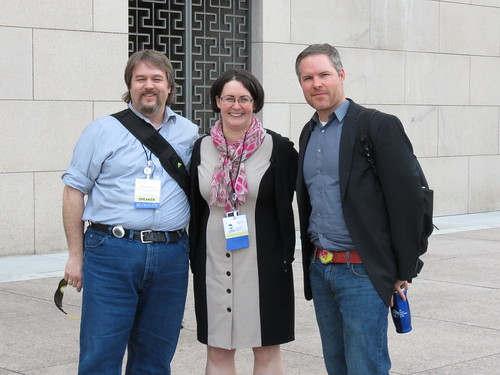Co-Director Harvard Library Innovation Lab, Harvard University and & Author, Too Big To Know; Everything is Miscellaneous: The Power of the New Digital Disorder, & Co-Author,Cluetrain Manifesto
Notes
* Why hacking now?
Libraries squeezed: cut costs or increase value
Hacking: fresh thinking that finds new opportunities for increasing the value of a system perhaps in unintended ways. (White hat hacking). (vs Exploit hidden weakness of systems for personal gain. (black hat hacking))
Bozo hacking: couch into car…. bungee cord tried to defy law of physics.
Why opportunity now for hacking in libraries?
- Networking of everything [not just going digital] (Digital provides access; networking allows interaction)
- Opening of Everything: from closed by default to open: Creative Commons/Open Access/Open Source/Open Education –> “there seems to be a consensus that open access is an inevitability” – Stuart Shieber, 2012
- Lifecycle Engagement: in old architecture: Author –> Distribution –> Readers; Now, because readers are networked, readers connect to one another across the world; connect directly with the author. Talking with one another in public, and development of ideas, value is in the development of ideas, in public, in the new public of the web. Physical objects typically cut off from those conversations. Now, conversations in public place, online.
- New Networked Ecoystem: Google Books, Wikipedia, Amazon instead of Library: How do we get libraries into the game
* Why isn’t every knife a Swiss army knife? Every possible tool. World of utility. Cultural assumptions.
Swiss army knife is a hack — we don’t have replicators: which tools do we hack together? Anticipation…
It’s negative to have too many tools on a Swiss Army knife. Need to decide which tools we really need. #cildc —@LauraSolomon
love @dweinberger mega swiss army knife analogy — A Swiss Army knife is a hack, preparing for what people “might” need. #cildc —@technolibrary
Filtering…reducing number of clicks that it takes for readers to get to materials. Filtering on the web is a filtering forward, not filtering out. We curate.
Anticipate needs for: Collections; cataloging; shelving; space; services. –physical and digital.
Base fields for Tibetan Buddhist Resource Center — metadata, that is Dublin-Core based. Anticipation didn’t have replication_of metadata in existing system.
Put platform underneath library services: one service that the library provides. Portal has open data. Collections; Social; Mashups; Analytics; Recommendations; Games; Browser; Open data usage, items, reviews, notes. With a platform, others can create their own interface on top of it.
Sounds a lot like Bibliocommons 🙂
DPLA platform metadata is open. App Library
Library Cloud at Harvard project
Item; Event; LCC; API’s; MARC holdings; usage links; item IDs.
StackLife project: OPAC alternative will be checking this out for sure!
StackLife catalog: ow.ly/i/59PMb really interesting open source catalog. @dweinberger: “please use and customize” #cildc —@AlexZealand
Point of platform is to mashup do things with it that you want to do.
Library platforms isn’t only digital. Labrary at Harvard. Library Lab at Harvard.
Awesomebox.io return box. lil@law.harvard.edu
Linked Open Data.
- Use URIs as names for things
- Use HTTP URIs so that peoplce can look up those names
- When someone looks up a URIs provide useful info using the standards RDP/SPARQL
- Include links to other URIs so that they can discover more things.
Linked open data allows synonymous terms to be linked.
System will get much smarter, much faster, when all this data is linked together.
Linked Data for Libraries: Cornell; Stanfard; Harvard Library Innovation Lab
Graphing Data. The side bar that appears in Google Searches that mashes up data together, basic facts… comes from graphing data. Google’s database of information crawled comes up with this.
Collaboratively libraries graphing data together. Possibilities endless
LIbraries hacking the future: do in public sphere, so world gets more value from it. Enrich existing assets and relationships, and librarian expertise. Community expertise — they notice relationships we haven’t. Infrastructure of knowledge. Allows us to continue infrastructure of knowledge — curation. Every point of view is challenged and should be challenged, even as we believe it. This is what libraries have always done. Providing sources, but showing disagreements among the sources.
We have a connected world, but the connections aren’t being made yet. They need to be made.
To capitalize on relationships, enrich existing assets, and fight the echo chambers, we need libraries curating @dweinberger #cildc —@queequegs
Yellow brick roads are wonderful, but they only take us in one direction…
